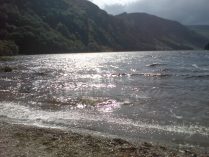All the way back during the last America’s Cup, I was watching the press conference after Day 1 of the Prada Cup Round Robins (which is a perfectly normal thing to do), and I was delighted to hear Ben Ainslie mention the INEOS team coach Rob Wilson, crediting him in part with coming up with the successful upwind strategy that helped the British boat to two wins that day.
And now, watching the 2024 Louis Vuitton Cup, Mr Wilson is turning up on our screens trying to sound nonchalant whilst the British boat is actually showing some speed:
Of course, I’m sure everyone remembers that around 8 years ago I briefly mentioned Rob Wilson in a post about the Optimist Selection Trials of 1989.
I’m sorry, what?
You don’t remember that?
Come on guys, pay attention.
Robert sailed at Littleton Sailing Club – a small lake club less than ten miles from the gravel pit that I learned to sail on. For that reason, I raced against him quite a bit over my Optimist years, and I got to admire the back of his boat from a range of angles and distances over that time.
I first heard of him when he was just 11 or 12. He won the prestigious Datchet Open – which was the end of season regatta and, to my mind anyway, a sort of unofficial Inland Championships.
It was a remarkable win for one so young, and it must have annoyed the hell out of quite a few 15-year-olds hoping for some last bit of Optimist glory.
Robert would go on to win a lot of Open meetings over the years I raced Optimists, but one in particular sticks in my mind – The Bowmoor Open of 1990.
I don’t remember much about the first race (other than calling “Starboard” on someone whilst I was on Port when I was in 3rd place and having to do a 720 – oh boy…), but according to the report in OP:NEWS (the Optimist magazine at the time) Rob won the first race, taking the lead at the last leeward mark.
The second race is described as follows:
Just after the start of the second race a major wind-shift left much of the fleet immediately out of contention. Andrew Simpson (yes, that Andrew Simpson) led to the first mark where he was overtaken by Richard Martin and Damian Lord (that would be me); that new order held to the finish with Martin winning from Lord and Simpson.
What the race report doesn’t mention is that Richard and I were clubmates, and for every beat for the remainder of the race Richard covered me so tightly I barely had enough air to breathe, let alone sail. I’m amazed I held on to second place. He was a super sailor (and would probably have beaten me by more if he’d ignored me altogether), but it was his first Open Meeting race win and he was determined not to lose first place – and rightly so.
All this meant that there were a lot of potential overall winners going in to the last race. The wind dropped from a gentle Force 2 to even lighter, and even as the fleet went onto the last beat it was still anyone’s regatta. Rob Wilson gained the lead at this late stage and looked set to win the Open when, out of the blue, he capsized. My memory is that he messed up a roll tack, although the race report he was “caught out by a 90 wind-shift”. It was quite probably a bit of both.
Anyone who has sailed Optimists (or had kids who have sailed Optimists; or indeed who have ever seen an Optimist…) will know that capsizing is a bit of a nightmare. Unlike self-draining modern boats, the Optimist is a bathtub without a plughole, and the only way to empty it is to bail it out.
For most people this would be race over, at least in terms of finishing first.
Not for Rob Wilson.
Somehow (and to this day I have no idea how) he managed to bail the boat out and win the race.
It was an impressive performance, if slightly annoying for the rest of us (although the fact that I finished 3rd overall, through a complete fluke of results (I had a 2nd and a 6th to count), meant that I wasn’t overly upset by the whole thing).
So it seems that Rob Wilson has a bit of experience coming back from a seemingly impossible situations – something that must have come in useful as a coach for the INEOS team over the years.
Who’d have thought that some America’s Cup level resilience could be forged in the light airs of an Optimist Open meeting at a small lake in England?
Not me, anyway.
